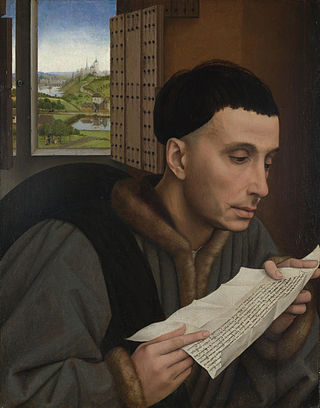
Brittany is a peninsula, historical country and cultural area in the north-west of modern France, covering the western part of what was known as Armorica during the period of Roman occupation. It became an independent kingdom and then a duchy before being united with the Kingdom of France in 1532 as a province governed as a separate nation under the crown. Brittany is the traditional homeland of the Breton people and is one of the six Celtic nations, retaining a distinct cultural identity that reflects its history.

Ivo of Kermartin, TOSF, also known as Yvo, Yves, or Ives, was a parish priest among the poor of Louannec, the only one of his station to be canonized in the Middle Ages. He is the patron of Brittany, lawyers, and abandoned children. His feast day is 19 May. Poetically, he is referred to as "advocate of the poor".

Plougastel-Daoulas is a commune in the Finistère department, located in the administrative region of Brittany, northwestern France.

The Church of St. Louis of the French is a Catholic church near Piazza Navona in Rome. The church is dedicated to the patron saints of France: Virgin Mary, Dionysius the Areopagite and King Louis IX of France.

Tréguier is a port town in the French department of Côtes-d'Armor, Brittany, northwestern France. It is the capital town of the province of Trégor.

Sant'Ivo alla Sapienza is a Catholic church in Rome. Built in 1642–1660 by the architect Francesco Borromini, the church is widely regarded a masterpiece of Roman Baroque architecture.

The Bretons are an ethnic group native to Brittany, north-western France. They trace their heritage to groups of Brittonic speakers who emigrated from southwestern Great Britain, particularly Cornwall and Devon, mostly during the Anglo-Saxon settlement of Britain. They migrated in waves from the 3rd to 9th century into Armorica, which was subsequently named Brittany after them.

Quimper Cathedral, formally the Cathedral of Saint Corentin, is a Roman Catholic cathedral and national monument of Brittany in France. It is located in the town of Quimper and is the seat of the Diocese of Quimper and Léon. Saint Corentin was its first bishop.

Corentin of Quimper is a Breton saint. He was the first bishop of Quimper. Corentin was a hermit at Plomodiern and was regarded as one of the seven founding saints of Brittany. He is the patron saint of Cornouaille, Brittany, and is also the patron saint of seafood. His feast day is December 12.

Tréguier Cathedral is a Roman Catholic church and former cathedral in Tréguier, Côtes-d'Armor, France. It is dedicated to Saint Tudwal. The church was formerly the seat of the Bishopric of Tréguier, abolished under the Concordat of 1801, when its territories were divided between the Diocese of Quimper and the Diocese of Saint-Brieuc, known since 1852 as Saint-Brieuc-Tréguier.

Amanlis is a commune in the department of Ille-et-Vilaine in the region of Brittany in western France. The inhabitants of Amanlis are known as Amanlisiens.

Sainte-Anne-d'Auray is a commune in the Morbihan department of Brittany in north-western France. It is the third most popular pilgrimage site in France, after Lourdes and Lisieux.

Gouesnac'h is a commune in the Finistère department and administrative region of Brittany in north-western France.

La Chapelle-de-Brain is a commune in the Ille-et-Vilaine department in Brittany in northwestern France.

Yves Hernot is the name of two sculptors, father and son, who ran the Ateliers Yves Hernot sculpture workshop in Lannion, Brittany, which specialised in creating Calvaries and tombs.
Saint-Yves, Saint Ivo, or Sant'Ivo can refer to:

According to late traditions, Clair was the first bishop of Nantes, France in the late 3rd century. He is venerated as a saint in the Catholic Church.

Ludovico Seitz, or Ludwig Seitz was an Italian painter of German ancestry, who served as Director of the Vatican Galleries.
Guillaume de Montfort, was a 15th-century French cleric, Bishop of Saint-Malo and cardinal.



















